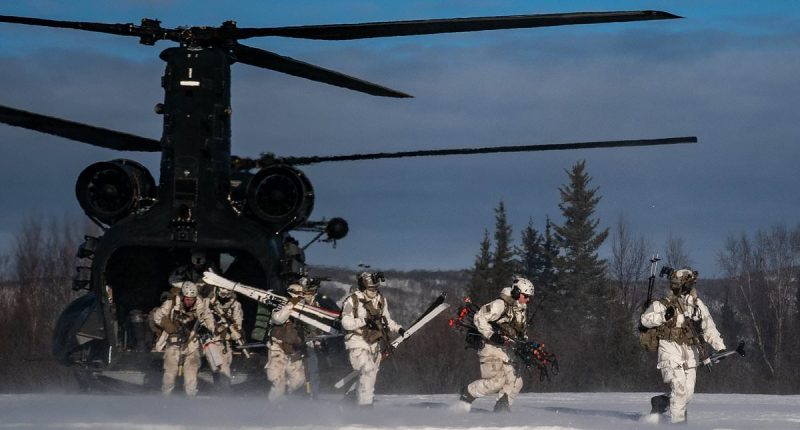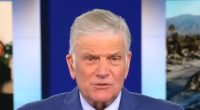Share this @internewscast.com
America and Canada were until recently the world’s leading ‘BFFs’ — they share the longest border on the planet, have fully integrated armed forces, and routinely voted for the other as their ‘favorite’ foreigners.
That goodwill has evaporated within weeks, as President Donald Trump slaps tariffs on its northern neighbor, threatens to annex a ’51st state,’ and as Canada scrambles to find new defense buddies.
As the $762 billion US-Canada trade relationship hits a crisis point, security chiefs on both sides of the border are asking whether their decades-old military alliance, perhaps the tightest tie-up to date, has a future.
The rupture comes as international competition heats up in the nearby Arctic, with its coveted minerals and shipping lanes, and where Russia builds bases and America eyes another land grab in Greenland.
Analysts told the Daily Mail that US-Canada ties would not collapse overnight, but that military cooperation was already suffering and could get worse, perhaps even hurting mutual defenses from a Russian or Chinese nuclear attack.
The stakes could not be higher. Just a single nuclear warhead hitting New York, Toronto, or another North American city would claim tens of thousands of lives and leave many more burned, maimed and sickened by radiation.
Against this scary backdrop, Christopher Hernandez-Roy, a former official at the Organization of American States, says Trump’s threats are eroding defense ties just weeks before a pivotal Canadian election on April 28.
‘The first couple of times he spoke about annexing the 51st state, it might have been funny. When you say it over and over, that’s a form of coercion,’ Hernandez-Roy told the Daily Mail.

Military training exercises like this one at the North Pole in Alaska are becoming more common as Arctic competition heats up

US Vice President JD Vance last month toured the US military’s Pituffik Space Base in Greenland on March 28. The US says the Danish territory must come under Washington’s control
‘The trouble is, there are ill feelings now, and broken trust, which makes it harder for whoever leads Canada to be seen to appease the US, even if it’s on something like missile defense that’s in Canadians’ interests.’
Trump has in recent weeks slapped 25 percent tariffs on Canadian automobile, steel, and aluminum imports, and called Ottawa a burden on the US that lets migrants and fentanyl spill across their shared border.
He says the US subsidizes Canada by some $200 billion a year, a disputed figure, and that it relies on Washington for security — with some justification, as Ottawa devotes just 1.4 percent of its economy to defense.
Trump in January said ‘we take care of their military’ and offered Canada the use of a 40 planned US Coast Guard big icebreakers if it became a US state, adding: ‘But I don’t like doing that if they’re a nation.’
He is meanwhile making a play for the wider Arctic region.
Vice President JD Vance last month visited Greenland, a mineral-rich, strategic Danish island that Trump says must fall under US control.
Canadians have reacted angrily to Trump’s hectoring. After he became prime minister last month, Mark Carney, a banker, said the long-standing amity with the US was ‘over,’ meaning an end to economic integration and shifts on security cooperation.
He’s started to loosen military links with the US, bolster other alliances, and moved to boost Canada’s military and security presence in the Arctic, a frozen and mineral-rich expanse that is of increasing interest to Trump.
Carney announced a review of a $13.3 billion deal to buy 88 F-35 stealth fighter jets from US defense giant Lockheed Martin, while talking to the UK, France and other European allies about boosting mutual defense and joint procurement projects.
He could yet scrap the F-35 deal with America in favor of buying the Eurofighter Typhoon, France’s Dassault Rafale or Sweden’s Saab Gripen, and even building one of those fighters in Canada as a boost to its economy.

The US and Canada have enjoyed decades of tight defense cooperation through Northcom and Norad, both headquartered in Colorado

Canada could yet scrap a $13.3 billion deal to buy 88 F-35 stealth fighter jets from US defense giant Lockheed Martin

Nuclear submarines, such as this American vessel, can hide beneath the Arctic ice and unleash doomsday weapons on unsuspecting enemies
Canada’s Foreign Affairs Minister Melanie Joly says it’s time for ‘new partnerships.’ Ottawa suffered from an ‘over-reliance on American procurement, particularly in the defense sector’ and now faced a threat to its sovereignty from the White House.
Carney has also announced plans to buy an early warning radar system from Australia — not the US — at a cost of $4.2 billion. Still, it will be deployed under the joint US-Canadian command, known as Norad.
He’s now under pressure to retreat from a roughly $22-billion deal for three River-class missile-carrying destroyers that use the Lockheed Martin-designed and built Aegis system, which is made in the US.
Hernandez-Roy, a fellow at the Washington-based think tank, the Center for Strategic and International Studies (CSIS), says Canadians are so offended by Trump that politicians of all stripes must now toughen their talk against the US.
US tariffs on Canada have helped to revive the fortunes of the Liberal Party, now led by Carney, in the election, and dented the appeal of the Conservative Party’s populist ‘Canada First’ leader Pierre Poilievre.
The vote is now a referendum on which leader can go head-to-head against Trump and defend Canada’s interests, says Hernandez-Roy.
This favors Carney, who previously led both the Bank of Canada and the Bank of England.
The top concern for Canadian and US generals is whether the gulf between the two countries widens further, penetrating the core of their military alliance — the North American Aerospace Defense Command (Norad).
Established in 1957 and headquartered in Colorado, Norad is the world’s only bi-national command, which detects and controls all air and maritime foreign threats to the North American landmass.

Donald Trump says the US subsidizes Canada by some $200 billion a year, a disputed figure, and that it relies on Washington for security

US Navy SEALs undergo grueling cold weather training in Kodiak, Alaska, in the increasingly contested Arctic

Canadian prime minister Mark Carney says the long-standing amity with the US was ‘over’

US Army Special Forces and Danish special operators train on snowmobiles at Fort Wainwright military base in North Pole, Alaska
Carney’s moves away from the US so far have focussed on military procurement, says Hernandez-Roy, and do not yet threaten to undercut common missile defense. There are even US-Canada talks about expanding cooperation under Trump’s ‘Golden Dome’ scheme.
Henry Ziemer, another CSIS analyst, says a ‘complete unraveling’ of US-Canadian military ties IS ‘unlikely,’ even if Washington walks away from the European members of the NATO alliance.
‘The threats both countries face, especially in the Arctic, where Russia and China have been making more aggressive moves, remain the same,’ Ziemer told the Daily Mail.
‘Neither country can afford to lose the other when it comes to defending the airspace, oceans, and access to early-warning radars for incoming missile attacks.’








